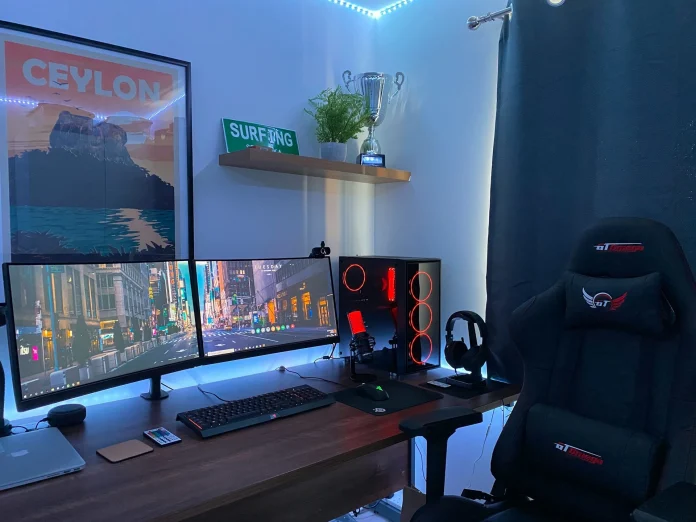If you’re someone who’s on the market, looking to build a gaming PC – AND you have a decent amount of money left in your budget for a good monitor, you’d be lying if you told us that you haven’t considered an OLED monitor.
OLEDs vs LEDs are like the blue vs red gang in gaming. One side preaches for excellent crisp visuals with deep blacks and the other for faster response times and overall higher brightness. Despite having fairly similar sounding names, OLED & LED monitors function differently – but don’t worry! We’ll hold your hands throughout the explanation
Kicking things off, let’s understand what OLED and LED panels are, how they differ and finally which kind of audience should buy either of the technology for their gaming rig.
What is an LED panel?
As of today, LED panels are the most purchased display technology in the market and have been extremely reliable over the last decade. The LED (which is a light emitting diode) which is a part of the backlight panel – that illuminates a liquid crystal display or otherwise known as LCD, to create the beautiful visuals that you see on the screen.
Understand the difference between an LCD and an LED display because they’re not competitors but more so complimentary in a sense where LCD is the element that controls what reaches your eyes and LED is what gives the lighting from behind the LCD layer.
Here’s where it gets interesting. LEDs have some advantages over an OLED panel, that’s right. They do not have screen burn-ins, which means a part of an image that is continuously displayed on the same zone on the panel – gets burnt in on the OLEDs and keeps lingering regardless of what is being shown on the screen (for example game HUDs or system taskbar and so on). They also can achieve insane brightness levels and finally, they are way more affordable than an OLED panel of the same size.
What is an OLED panel?
Well, OLEDs and LEDs may sound similar, but they function in ways that aren’t even in the same league. For traditional LED/ LCD panels, the backlight is always on – which means the source of light remains constant and seeps through to the outermost layers – causing blacks to well, look like grays. This is also visible in the bleeding on screen edges, that causes semi white patches to prop up as the display gets older / damaged.
OLED on the other hand, is an organic light-emitting diode – where an array of pixels have these OLEDs and each pixel generates its own light through what’s called the electroluminescent layer. Basically, it means each pixel can kind of go “black” because they simply won’t be powered on at all. And what is blacker than a zone where there’s no light?
This is what allows OLEDs to reproduce deep inky true black color, have higher contrast ratios, and higher sharpness along with colors that feel richer and more lifelike
Features of OLED, and why they matter

Well, since you now know what OLED panels are and how they work here are some benefits to getting an OLED monitor – for work or for general-purpose uses.
Inky Blacks
An immediate striking difference between an OLED and an LED display is how they handle contrast and the color “black”. Since each pixel can be turned off completely, the deep inky blacks – especially pronounced when seen in a dark environment will stand out.
LED monitors have a backlight panel – which means all the zones are constantly lit, which means all the light seeps through to the front making blacks – not truly black.
Drastic jump in viewing angles
Think about this, if there is no polarizer layer’s “thickness” involved, the lack of backlighting – directly translates to crystal clear visuals, even if you are seated at an extremely weird spot in the room, where you have to tilt your head to watch the screen. Essentially, what we mean is – no more neck pain!
Easy to transport!
One terribly underlooked factor about OLED panels – is the way they are designed, which means unlike the LCD counterparts – where you have various components, the organic layers are lightweight, meaning they weigh way lower than LCD displays of equivalent size.
This means, easier to transport, can be set up, mounted and carried with way less effort. Another cool thing to note is how OLED panels have thinner layers and are more “malleable & flexible” making them less prone to damage while in transit.
Lower blue light effects
OLED is able to lower brightness on demand, which means the blue light emitted by the pixels is less than half the levels emitted by LED/LCD panels. But why does it even matter you may ask – that is because blue light can strain the eyes when viewed for prolonged hours. It is one of the leading causes for eye strain – which over time can accumulate causing fatigue, can affect sleep cycles and cause headaches over the day!
So basically, if you get an OLED with low blue light emission – your eyes will thank you for it!
Reduced Power Consumption
The energy-saving features of OLED displays operate through independent pixel control. The control system enables independent pixel management which allows complete power shutdown of inactive pixels on screen. OLED monitors reduce their power usage more effectively than LED screens do while operating at the same adjusted brightness levels. Education facilities and workplaces assist from the energy-saving characteristics in multiplex monitor use scenarios.
A significant benefit of OLED technology is its environmentally-friendly nature starting from production up to the use phase. The production process of OLED panels avoids using nitrogen trifluoride since this greenhouse compound is specific to LED/LCD screen manufacturing. A more environmentally friendly technology choice exists through OLED because it conserves energy both during operations and in its manufacturing process.
Faster Response Times
The swift response time of OLED technology results from its reduced input delay which makes it a significant advantage. The connexion between your mouse clicks and display reactions becomes quicker because of OLED technology. OLED technology delivers a smoother and more dynamic screen experience due to its abilities.
Rapid response speeds represent a fundamental benefit of OLED displays because they help reduce both input delay and motion blur conditions that tend to affect LED/LCD displays. People viewing moving objects on-screen often notice a temporary stop or fading tracks because OLED exhibits its expertise during this moment.
But before we conclude that OLEDs are the best, here’s something to remember.
Burn in concerns with OLED panels
OLED screens continue to be affected by the burn-in issue. Manufacturers have taken steps to fight burn-in however this issue still persists mainly when users show static elements on-screen too often (such as game HUDs or system bars).
The Verdict: Which is Right for You?
Ultimately, the “better” technology depends on your individual priorities and budget.
Choose OLED if:
- Image quality is paramount: You prioritize deep blacks, vibrant colors, and stunning visuals.
- You can afford the premium: OLED monitors generally come at a higher price point.
- You’re concerned about eye strain: OLEDs typically emit less blue light.
- You value fast response times and minimal motion blur.
Choose LED if:
- Budget is a major concern: LED monitors are significantly more affordable.
- You’re highly concerned about burn-in.
- You require extremely high brightness levels.
- You prioritize longevity: LED monitors generally have a longer lifespan.
Beyond the Specs:
Remember to consider these factors:
- Gaming Genre: Fast-paced esports titles might benefit more from the speed of an LED.
- Viewing Environment: If you play in a dark room, OLED’s contrast will be more noticeable.
- Monitor Size: Larger OLEDs can be more expensive, while LED options are readily available in a wider range of sizes.
That’s all for today folks, and for more such informative guides on technology, keep watching this space only on Talkesport!


